
Fukushima fish 'may be inedible for a decade'
福島の魚『10年は食べられないかもしれない』
Marine scientist finds levels of radioactivity in fish near stricken Fukushima nuclear plant are higher than expected
海洋科学者、崩壊した福島原発近くの魚に、予測以上高い放射能レベルを発見
Fiona Harvey, environment correspondent guardian.co.uk,
Thursday 25 October 2012 19.00 BST
Fish from the waters around the Fukushima nuclear plant in Japan could be too radioactive to eat for a decade to come, as samples show that radioactivity levels remain elevated and show little sign of coming down, a marine scientist has warned.
福島原発周辺の水から獲れる魚は、これから10年は、食するには放射能が高すぎる可能性があります。サンプルが示した放射能レベルは今だ高く、下がる気配がほとんどない、と海洋科学者が警告しました。
According to a paper published in the journal Science on Thursday, large and bottom-dwelling species carry most risk, which means cod, flounder, halibut, pollock, skate and sole from the waters in question could be off limits for years, .
木曜日に発表されたジャーナル・サイエンス紙によると、問題になっている水中からの大きな、海底に住む種類、つまりマダラ、カレイ、オヒョウ、タラ、ガンギエイ、シタビラメが最も危険で、何年もの間限界値を超える可能性がある、ということです。
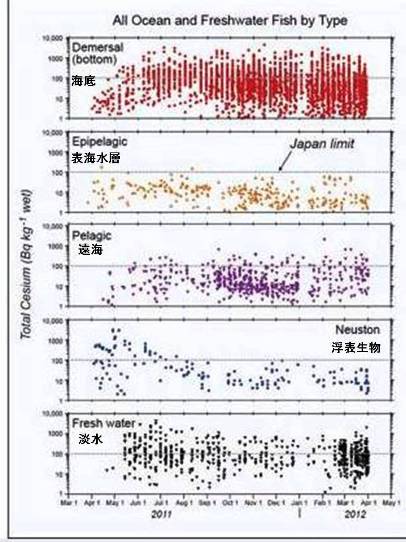
Sample fish caught in waters near the stricken reactors suggest there is still a source of caesium either on the seafloor or still being discharged into the sea, perhaps from what is left of the cooling waters. As the levels of radioactive isotopes in the fish are not declining as fast as they should have, the outlook for fishing in the area is likely to be poor for the next 10 years, the paper's author told the Guardian.
崩壊した原子炉近くの水で取れた魚のサンプルは、海底にセシウムの源があるか、まだ海にセシウム排出していることを物語っています。おそらく、冷却水に残っているものでしょう。魚の放射性核種のレベルが下がるべき速さで下がっていないので、その地域での漁の見通しは、これから10年は芳しくないだろう、とそのその著者は当誌に話しました。
"These fish could have to be banned for a long time. The most surprising thing for me was that the levels [of radioactivity] in the fish were not going down. There should have been much lower numbers," said Ken Buesseler, senior scientist at the Woods Hole Oceanographic Institution in the US, who wrote the paper titled Fishing For Answers Off Fukushima.
「これらの魚は、長期に渡り出荷禁止にしなければならないでしょう。私が最も驚いたのは、魚の(放射能)レベルが下がっていなかったのことです。もっと低い値であるはずだったのです。」と、福島沖の漁についての答え、と題した記事を書いたアメリカのウッズホール海洋研究所の科学者、ケン・Buesseler氏は話しました。

He said his findings – taken in part from Japanese research and sampling of fish in the area – showed how difficult it was to predict the outcome of a nuclear incident such as that at Fukushima. In 2011, after the earthquake and tsunami that struck Japan on 11 March and killed nearly 20,000 people, the nuclear reactors suffered a series of serious radiation leaks as their cooling systems failed, and workers fought frantically to try to shut them down. It was the world's worst nuclear accident since Chernobyl, in Ukraine in 1986.
その地域での日本の調査、魚のサンプリングに参加した彼が発見したことは、福島のような原子力事故の結果を予測するのがいかに困難なのかを示しました。2011年3月11日に日本を襲い、2万名ほどの人々の命を奪った地震と津波の後で、冷却システムが損なわれたために、原子炉は一連の深刻な放射能漏れを起こすことになり、作業員たちはそれらの原子炉を停止させるために半狂乱で戦ったのです。それは、1986年にウクライナで起こったチェルノブイリの事故以来、世界で最悪の原子力事故でした。
In the wake of the incident, the Japanese government sought to calm public fears by lowering the levels of radioactivity that would mean a fish was deemed unsafe for human consumption. As of April 2012, fish can only be sold in Japan if it contains less than 100 becquerels of caesium 134 and 137 in seafood per kilogram of wet weight, down from a previous limit of 500 becquerels.
その事故の後で日本政府は、人が消費して危険だとみなされる魚の放射能レベルを下げることで、人々の恐怖心を静める策を探りました。2012年の4月をもって、日本で売られる魚は、それまでの1kgあたり500ベクレルの限界値から、海産物に含まれるセシウム134と137の値が1kg(乾燥していない状態で)あたり100ベクレル以下でなければならない、としました。
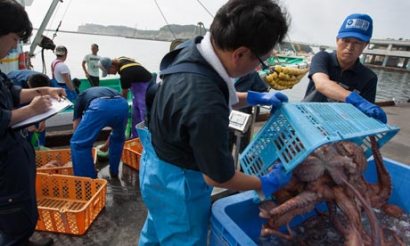
Buesseler said this was not because scientific advice had changed, but because the government wanted to reassure people. "This is not lethal – I'm not trying to be alarmist," he said. "But the levels [of radioactivity in the fish] are measurable and consistent. It's a small increase in risk."
これは、科学的なアドバイスが変わったからではなく、政府が人々の不安をなくしたかったからだ、とBuesseler氏は言います。「これは、致命的なものではありません。-私は人騒がせなことにならないようにしています。しかし、(魚の放射能)レベルは測定できるほどのもので根強いものです。そして、少し危険度を増やすものです。」
However, eating large quantities of such fish over a long period could be harmful, he said. Fish is a more important part of the Japanese diet than in countries such as the US and the UK.
しかしながら、そのような魚を長期に渡ってたくさん食べることは、有害になりうるだろう、と彼は述べました。魚は日本人の食生活にとっては、アメリカやイギリスよりも重要なものなのです。
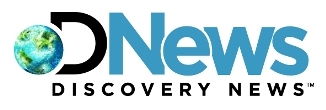
Discoveryニュースからの抜粋です。
...The finding suggests that the region's coastal-dwelling fish are still being exposed to new sources of cesium, possibly from the seafloor or from contaminated groundwater that's flowing into the ocean. And even though most fish sampled in the new study had levels of cesium below safe limits for consumption, some fish contained surprisingly large amounts.
その発見は、その地域の海岸に生息している魚が、まだ新しくセシウムを取り込んでいることを示しています。おそらく海底、あるいは汚染された地下水が海に流れ込んでいるのでしょう。新しい研究での魚のサンプルのセシウムのレベルが消費の安全限界値は下回いますが、いくつかの魚は、驚くほど大量のセシウムを含んでいました。
..."If (the cesium) is in the seafloor, it could be many years or even decades for that to go away," said Ken Buesseler, an oceanographer at the Woods Hole Oceanographic Institution in Mass. "That implies we're going to have an issue in coastal fisheries for a long time to come in Japan. We certainly can't say we're out of the woods yet."
もし(セシウムが)海底に在るのであれば、それは、なくなるまでに何十年までもかかるでしょう。」と海洋学者のケン・Buesseler氏は言います。「それは、日本で、長年にわたり沿岸の漁業にとって問題であり続けるということを示唆しています。私たちはまだ危機を乗り越えたとはいえません。」
..."Just because you haven't read about it in the news" lately, he added, "doesn't mean it has gone away."
最近「ニュースで聞かなくなったというだけで、問題がなくなった、ということではないのです。」と彼は付け加えました。
...He was immediately struck with the realization that radiation levels in fish had not dropped in the past year. Fish naturally lose a few percent of their concentrations of cesium if they are not re-exposed, Buesseler said, suggesting that the animals are still facing new inputs of the radioactive material.
彼は、すぐさま去年から魚の放射能レベルが下がっていないと気付きました。もし繰り返し被曝しなければ自然に濃縮されたセシウムの数%が減ってくくので、魚がまだ新しい放射性物質を摂取していると考えられる、とBuesseler氏は話しました。
...More than 40 percent of fish in the region contained levels greater than the new safe-consumption limit of 100 units per kg. Two greenling fish collected this August contained a surprisingly high level of 25,000 units.
その地域の40%以上の魚が、安全基準地の1kgあたり100ベクレルを上回ったレベルでした。今年の8月に採取された2匹のアイナメは、25,000ベクレルという驚くべき高いレベルを含んでいたのです。
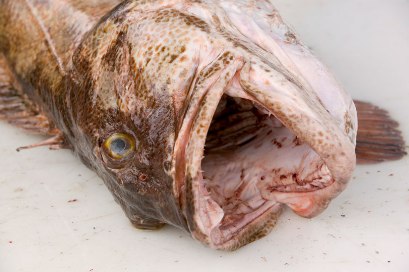
For his part, Buesseler ate all of the seafood he was offered on a trip to Japan in July.
自分はどうかというと、Buesseler氏は、7月の日本訪問の際、出された海産物は全て食べました。
-----------------------------------------------------
北米西海岸でも新たな報告がありました。
Green Oregon: Tuna shows only trace radiation from Japanese nuclear disaster; offers clues to migration
グリーン・オレゴン:日本原子力惨事からのほんの微量の放射能を示すツナ(まぐろ)、移動経路の手がかりを示す
By The Oregonian
October 25, 2012 at 7:39 AM, updated October 25, 2012 at 5:17 PM
Albacore tuna caught off the West Coast show only traces of radiation from the Fukushima nuclear disaster, according to scientists from Oregon State University and the National Oceanic and Atmospheric Administration.
オレゴン州立大学とアメリカ海洋大気庁の科学者によると、西海岸沖で獲れたビンナガマグロ(缶詰によく使われる)が、ほんの微量の福島原子力災害由来の放射能を示しました。
And what radiation is detected is far below anything that would pose a risk to humans who consume the fish, the research team said in a press release Wednesday. The findings are preliminary with additional fish to be tested.
検出された放射能が、その魚を食べて人に与える危険性は、あまりにも低いものだ、と調査チームは水曜日の報道発表で述べました。その発見は、更なる魚の検査の予備検査です。
People are constantly exposed to radiation from the natural environment, said Delvan Neville, a graduate researcher with OSU's Radiation Health Physics program and a co-investigator on the project. "To increase their normal annual dosage of radiation by just 1 percent, a person would have to eat more than 4,000 pounds of the highest (radiation) level albacore we've seen."
人々は常に自然環境から被曝しているのだ、とオレゴン大学の放射線保健物理学の新卒調査員であり、このプロジェクトの共同調査員Delvan Neville氏は言いました。「通常の年間放射線被曝量を1%上げるためには、私たちが調べたビンナガマグロで最も高かった放射能レベルのものを4000ポンド(1014kg)以上食べなければなりません。」
Neville will present the team's preliminary findings Monday at the Heceta Head Coastal Conference in Florence.
Neville氏は、この予備検査の結果を、月曜日にフローレンスで行われるHeceta Head Coastal会議で発表します。
The OSU team's findings are consistent with those of California researchers who announced in May traces of Fukushima-linked radionuclides in bluefin tuna.
このオレゴン州立大学のチームの結果は、5月にクロマグロから微量の福島由来の放射性物質を発見したカリフォルニアの調査員が得た結果と一貫性のあるものです。
But finding the trace radiation in albacore is giving clues to the fish and its elusive migration patterns.
しかしビンナガマグロのわずかに見つかった放射能は、その魚のつかまえどころのない移動パターンを知る手がかりとなります。
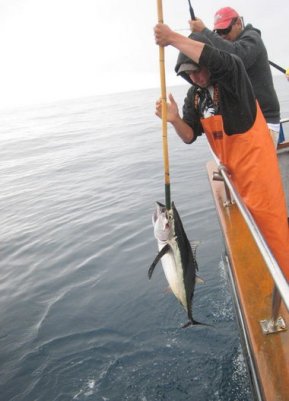
The researchers first identified two Fukushima-linked isotopes - Cesium-137 (Cs-137) and Cesium-134 (Cs-134) - this July, in samples of fish caught and frozen in 2011. Cs-134, in particular, is considered key to the Fukushima nuclear "fingerprint."
As more fish were tested, the results were consistent with the initial findings: No Cs-134 in fish caught before the disaster, but traces of the isotope in a significant number of fish caught since, according to the announcement.
調査員たちはこの7月にまず、2011年に捕獲され冷凍されていたサンプルに、福島由来の核種、セシウム137と134を特定しました。セシウム134は特に福島を特定するものとして考えられてる鍵です。多くの魚が検査されるにつれ、それらの結果は最初に見られたものと一貫性を示しました。発表によると、災害前に獲られた魚からはセシウム134が含まれず、災害後に獲られた魚からはかなり多くの魚に、微量のその核種が含まれていた、ということです。
"What we can say is that we have detected Cs-134 in fish thousands of miles from where that Cs-134 came from, and over a year since it was released," Neville added. "It's very interesting scientifically, and it can tell us more about tuna migration and what happens to radioactive releases, but it's nowhere near enough to be concerned about food safety."
「言えることは、セシウム134が放出されて以来1年以上たって、何千マイルも離れたところの魚から検出された、ということです。」とVeville氏は言い足しました。「科学的にとても興味深いことです。そして、このことは私たちに、マグロの移動経路と放射性物質の放出に何が起こっているのかを告げてくれるのです。しかし、食の安全については、心配するほどでは全くありません。」
-- The Oregonian
The Associated Pressの関係記事より抜粋
...Albacore tuna is a $41 million business in the Pacific Northwest, and fishermen from the region caught about 10,000 tons last year, according to the U.S. Department of Commerce.
ビンナガマグロは、北西パシフィックでは4100万ドルのビジネスです。アメリカの商務省によると、この地域からの漁師たちは、去年約1万トンを捕獲しました。
Washington fishermen accounted for about 53 percent of the haul, and the remainder came through Oregon docks.
ワシントン州の漁師たちの捕獲は、そのうちの53%を占め、残りは、オレゴンの埠頭からのものです。

The U.S. Environmental Protection Agency, Food and Drug Administration and NOAA have jointly stated they have "high confidence" in the safety of U.S. seafood products because the radiation levels are so low.
アメリカ合衆国環境保護庁、食品医薬品局、アメリカ海洋大気庁は共に、放射能のレベルがとても低いので、アメリカの海産物の安全にはかなり自信がある、と述べました。
The News Line onlineより抜粋
...Anglers at the Port of Ilwaco said they don't expect the news will cut into business because the amount is so small.
イリワコ港のAnglersさんは、放射能の量がとても小さいので、そのニュースでビジネスが減るとは思っていない、と話しました。
"Everything in the ocean has some type of contaminant in it. It's such a miniscule amount that you get more radiation walking by an X-ray machine," said Milt Gudgell, owner of Pacific Salmon charters, which operates four charter tuna boats during the tourist season.
「海のものは全て何かしら汚染されています。そのようにあまりにも少ない量で、レントゲンをかける方がよっぽど多くの放射線を浴びるのです。」とパシフィックサーモンチャーターズのオーナー、Milt Gudgell氏は言いました。観光シーズンには、4隻のマグロ釣りボートを運航しています。
-----------------------------------------------------------
注: 健康被害を問題ない、とする報告は、一般市民を守るためではなく、他の大きな勢力を守るためであることが多いことを、心に留めておきましょう。
Note: Please keep it in mind that the announcement reassuring people about the safety of small amount of radiation exposure is generally not aiming to protect their citizen or someone vulnerable, but to protect someone very strong with huge power.
